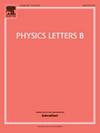黑洞最内层稳定圆轨道半径的上界
IF 4.3
2区 物理与天体物理
Q1 ASTRONOMY & ASTROPHYSICS
引用次数: 0
摘要
在这项工作中,我们研究了静态、球对称和渐近平坦黑洞时空中大质量粒子最内层稳定圆轨道(ISCOs)半径的普遍上界。通过对外部物质场的时空度量进行分析,利用有效势法推导出ISCO的特征方程。通过对物质场施加适当的能量条件,我们严格证明了ISCO半径以rISCO≤6M为界,其中M为黑洞的总ADM质量。史瓦西黑洞饱和于此界限(rISCO=6M),满足所施加能量条件的Reissner-Nordström黑洞、超重力黑洞、流体球模型也服从rISCO≤6M。这一上限的普遍性为天体物理学的观测提供了理论基准:吸积盘观测或引力波信号偏离6M可能表明奇异物质场的存在。这项工作突出了黑洞几何和外部物质场之间的相互作用,为未来致密物体动力学的研究铺平了道路。本文章由计算机程序翻译,如有差异,请以英文原文为准。
Upper bound on the radius of the innermost stable circular orbit of black holes
In this work, we investigate a universal upper bound on the radius of the innermost stable circular orbit (ISCOs) for massive particles in static, spherically symmetric, and asymptotically flat black hole spacetimes. By analyzing the spacetime metrics with external matter fields, we derive the characteristic equation for ISCO via the effective potential method. By imposing appropriate energy conditions for the matter fields, we rigorously demonstrate that the ISCO radius is bounded by , where M is the total ADM mass of the black hole. The Schwarzschild black hole saturates this bound (), and the Reissner-Nordström black hole, supergravity black holes, fluid sphere models, which satisfy the imposed energy conditions, also obey . The universality of this upper limit provides a theoretical benchmark for observational astrophysics: deviations from 6M in accretion disk observations or gravitational wave signals could indicate the presence of exotic matter fields. This work highlights the interplay between black hole geometry and external matter fields, paving the way for future studies in compact object dynamics.
求助全文
通过发布文献求助,成功后即可免费获取论文全文。
去求助
来源期刊

Physics Letters B
物理-物理:综合
CiteScore
9.10
自引率
6.80%
发文量
647
审稿时长
3 months
期刊介绍:
Physics Letters B ensures the rapid publication of important new results in particle physics, nuclear physics and cosmology. Specialized editors are responsible for contributions in experimental nuclear physics, theoretical nuclear physics, experimental high-energy physics, theoretical high-energy physics, and astrophysics.
 求助内容:
求助内容: 应助结果提醒方式:
应助结果提醒方式:


